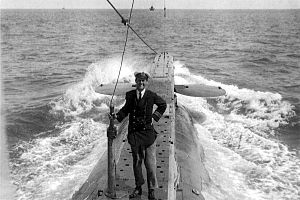Edward Courtney Boyle facts for kids
Quick facts for kids
Edward Courtney Boyle
|
|
|---|---|

Commander Boyle aboard HMS E14. Photo by Ernest Brooks
|
|
| Born | 23 March 1883 Carlisle, Cumberland, England |
| Died | 16 December 1967 (aged 84) Ascot, Berkshire, England |
| Buried |
Woking Crematorium
|
| Allegiance | United Kingdom |
| Service/ |
Royal Navy |
| Years of service | 1897–1932 1939–1943 |
| Rank | Rear Admiral |
| Commands held | Flag Officer-In-Charge, London (1939–42) HMS Iron Duke (1929–31) HMS Carysfort (1924–25) HMS Birmingham (1923) HMAS Platypus (1918–20) HMS J5 (1916–18) HMS E14 (1914–16) HMS D3 (1914) HMS D2 (1911–13) HMS C29 (1910–11) HMS C4 (c.1907–08) |
| Battles/wars | First World War Second World War |
| Awards | Victoria Cross Mentioned in Despatches Order of Saints Maurice and Lazarus (Italy) Legion of Honour (France) |
Rear Admiral Edward Courtney Boyle (born March 23, 1883 – died December 16, 1967) was a brave officer in the Royal Navy. He was awarded the Victoria Cross, which is the highest award for courage in battle for British and Commonwealth forces.
Contents
Edward Courtney Boyle was born in Carlisle, England, on March 23, 1883. He went to school at Cheltenham College.
In 1897, when he was 14, Boyle joined the Royal Navy. He started his training on a ship called HMS Britannia.
Joining the Submarine Service
Boyle became part of the Royal Navy's submarine service in July 1904. He was sent to a special ship called HMS Thames, which was a base for submarines. Soon after, he was promoted to lieutenant. He was given command of one of the early Holland-class submarines.
After some time serving on surface ships, he returned to submarines in 1910.
Heroic Actions in World War I
During the First World War, Edward Boyle was a lieutenant commander in the Royal Navy. He was 32 years old when he performed an act of great bravery. For this, he received the Victoria Cross.
Diving into the Sea of Marmara
On April 27, 1915, Boyle was in command of the submarine E14. He made a very risky decision: he dived his submarine under enemy minefields. This allowed him to enter the Sea of Marmara.
This was an incredibly dangerous mission. There were strong currents that made it hard to steer the submarine. Enemy patrols were always nearby, and there was a constant risk of attack. Despite these dangers, Boyle kept operating in the narrow waters of the Straits.
Sinking Enemy Ships
During this mission, Boyle and his crew successfully sank two Turkish gunboats. They also sank a very large military transport ship. This transport ship was called the Gul Djemal. It was carrying about 2,000 soldiers and a lot of artillery.
The sinking of the Gul Djemal was a major success. It stopped the Ottoman forces from sending more soldiers and weapons by sea to the Gallipoli Campaign. Because of Boyle's bravery, other members of his crew also received awards. Edward Geldard Stanley and Reginald Wilfred Lawrence received the Distinguished Service Cross. All the other sailors on board received the Distinguished Service Medal.
Boyle made at least two more dangerous trips into the Sea of Marmara aboard E14 during the Gallipoli Campaign.
Personal Life
In 1912, Edward Boyle married Marjorie Leigh in London.
Later Life and Retirement
Edward Boyle retired from the Royal Navy in 1932 with the rank of rear admiral. However, he was called back to serve during the Second World War. From 1939 to 1942, he served as the Flag Officer-in-Charge, London. This meant he was in charge of naval operations in London.
He passed away in December 1967 after an accident. His Victoria Cross medal is now on display at the Royal Navy Submarine Museum in Gosport, Hampshire.

